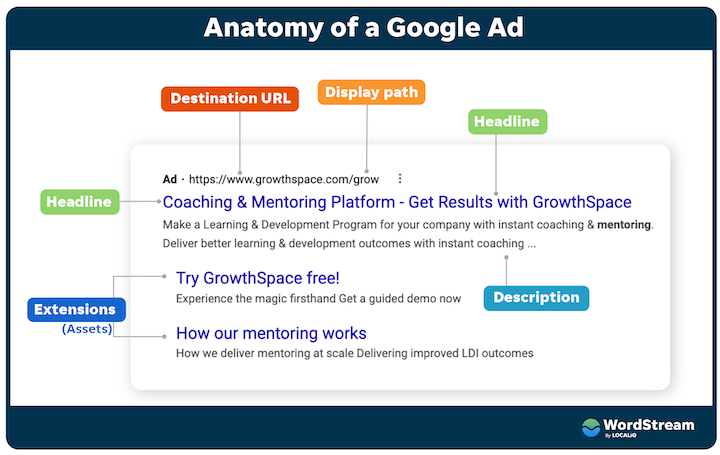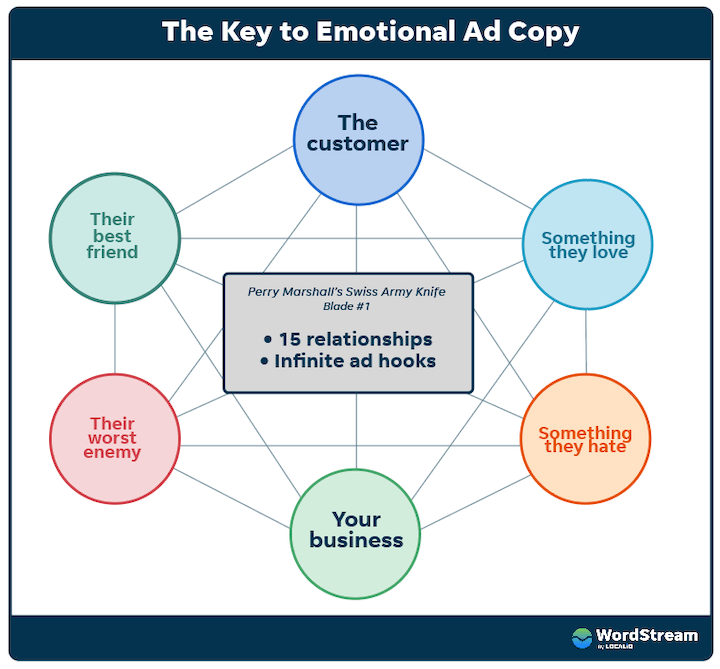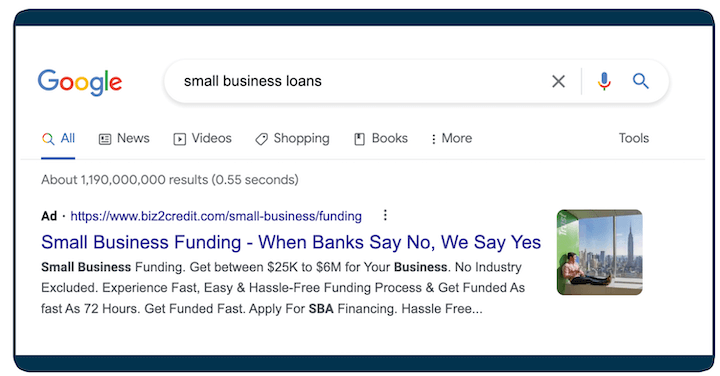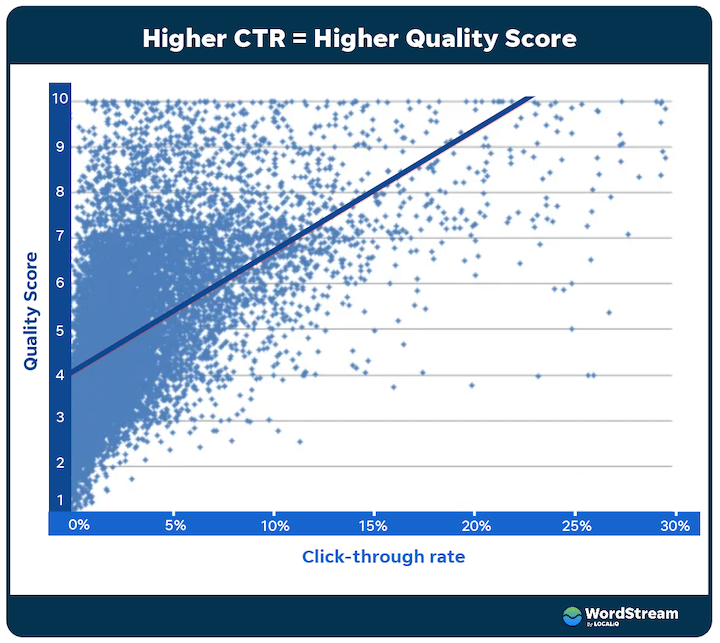
PPC is a great way to drive qualified traffic to your site—but not if nobody clicks on your ads. Even worse, a low click-through rate can bog down your Quality Score which will hike up your ad costs.

That’s why writing exceptional ad copy is the most important thing you can spend your time on in paid search.
Soo…what is exceptional ad copy? It’s copy that doesn’t just follow best practices, but also pays attention to the finer details your competitors are missing.
In this guide, I’m sharing 10 tricks for crafting compelling PPC ads that earn high Quality Scores, grab customer attention, and capture clicks—all in the name of more conversions and lower costs.
Table of contents
- The anatomy of a Google text ad
- Responsive search ad copy best practices
- 10 tricks to write exceptional PPC ads
- PPC ad copy template
Part one: The anatomy of a Google text ad
To get to the part where we’re writing our finest ad copy, we first need to cover the basics for text ads on Google (which are called Search campaigns). Here are the components:
- URL: Also known as the destination, this is where users will land when they click on your ad.
- Display path: This is what appears after the URL, after the slash. It’s called “display” because it doesn’t have to be the actual URL of the page. It’s what gets displayed as a part of the ad and is used to provide more clarity to the user about the destination of the link. More on this in a bit.
- Headline: The headline is the large blue text that appears below the URL. This is the most prominent part of your ad and most likely the first (and sometimes only) thing users read. Ads can have two or three headlines, up to 30 characters each.
- Description: The description is the body text that appears below the headline and provides more details. These can be up to 90 characters.
- Assets: Formerly known as extensions, these are additional elements you can tack onto your ad to give it more appeal. There are sitelinks, phone numbers, images, promotions, and more. Note that they aren’t guaranteed to show with every impression. Learn more in our extensions/assets cheatsheet.
Part two: The 5 responsive search ad copy best practices
Okay, one more housekeeping item because responsive search ads are the only type of search ad you can create (on both Google and Bing), and these guys are shifty little shapeshifters, so they can be a little tricky when it comes to ad copy.
And by shapeshifter, I mean that you input a number of headlines and descriptions and Google will rotate different combinations based on the searcher, search query, and more.
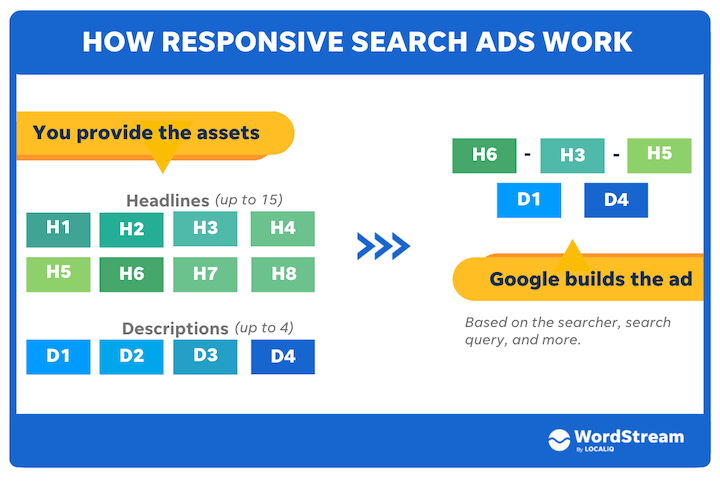
Which means that you need to input headlines that could all work in combinations. This is the tricky part, which is why you should know the best practices for responsive search ad copy. You’ll also find that they tie in nicely with our PPC ad copy tips in the next section.
- Embrace multiple headlines. Don’t use the bare minimum. Use at least 8-10 of the 15 headlines, and at least three of the four descriptions available to you.
- Keep your headlines distinct. Google will not show similar variations.
- Don’t put keywords in every headline. At least three of your headlines should not be keyword-focused—as in, they should be feature, benefit, or CTA instead.
- Don’t over-pin. It can be tempting to freeze certain headlines in place, or even all of them, but this limits Google’s ability to test out different combinations and maximize performance.
- Vary headline lengths. Don’t use all 30 characters for every headline. This will allow Google to show some ads with two headlines and some with three.
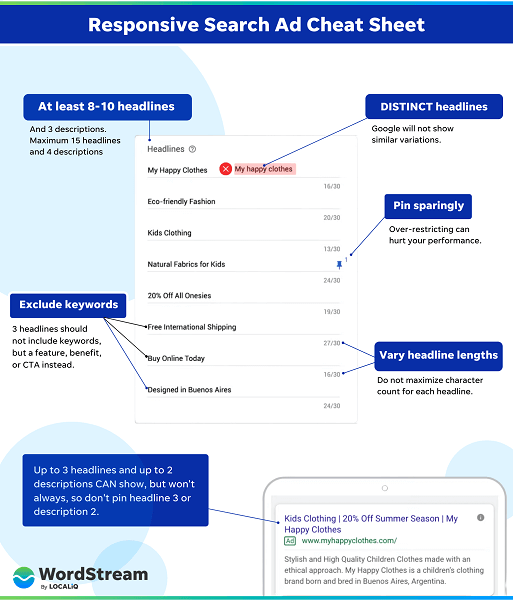
Part three: 10 tricks to write exceptional PPC ad copy
Now that we know what we’re working with here, we can get to the good stuff—how to write PPC ad copy that earns high Quality Scores, captures attention, and gets the clicks.
1. Think feature-benefit-feeling
As we just learned above, not every headline needs to include the keyword you’re targeting—some of them should include features and/or benefits. Features and benefits are a staple in any sort of marketing copy, but all too often, we neglect the most important part: emotion.
Why does the user want the benefit to happen? What, ultimately, is the good feeling they are trying to achieve or the bad feeling they’re looking to avoid?
For example, let’s say you are running an ad for public speaking coaching:
- Feature: One-on-one coaching
- Benefit: Become a better public speaker
- Feeling: Confidence
- Headline: Speak with Impact & Authority
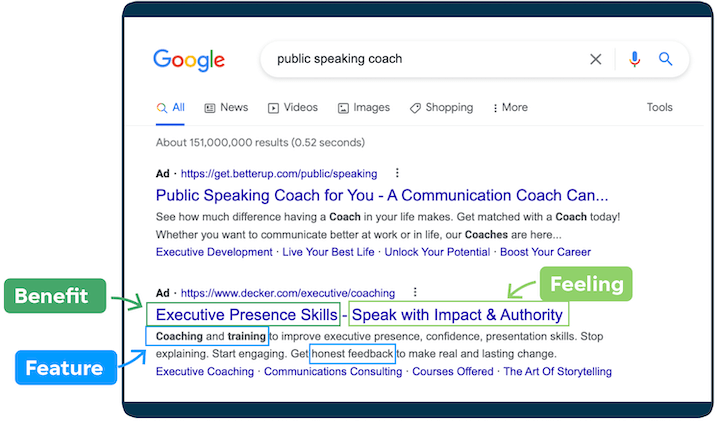
For more inspiration, check out these examples of emotional ad copy—which includes 97 words and phrases to try out.
2. Include a differentiator
So you’ve established your key features and benefits. Great. But guess what—your competitors provide the same exact ones. Don’t worry, I know yours are different on a more detailed and nuanced level, but you can’t capture that in a single text ad, so for all intents ad purposes on the SERP, in consumers’ eyes, it’s all the same.
So you need to identify what makes you different. This is the key to any good elevator pitch or scenario where you have limited time and space.
This is easy when you are any of the following:
- The original
- The official
- The only
- The fastest
- The first
- The lowest-priced
- The top rated
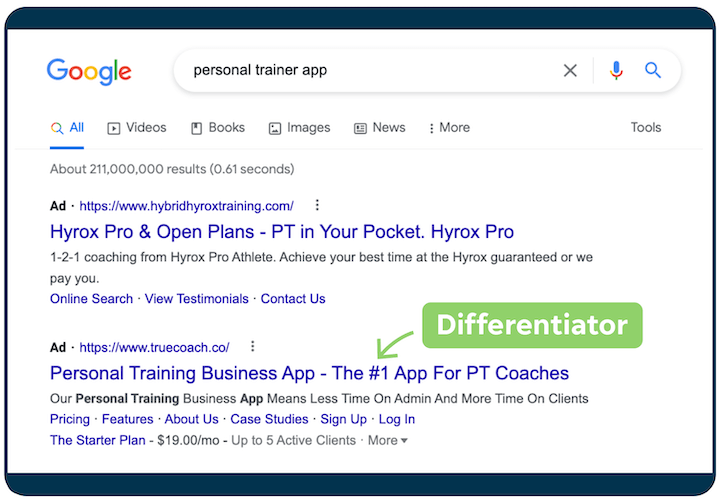
But even if you’re not any of the above, you can still differentiate your business from competitors with things like:
- Specific numbers (such as reviews and ratings).
- A particular endorsement.
- A “not your typical” or “not your average” statement.
- A “this, not that” statement.
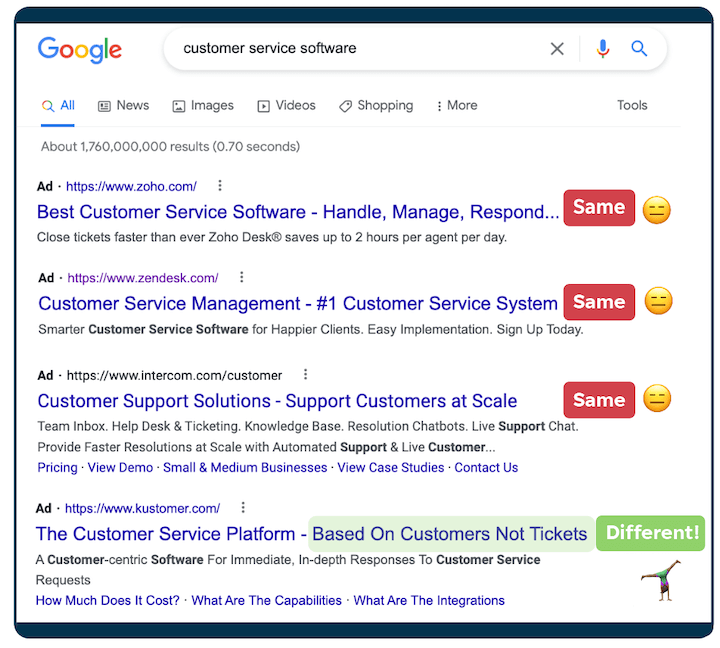
Just something that makes your ad copy different from all the other ads around it. “Different” stands out. And standing out is attractive.
3. Show a little personality
Another way to differentiate your business from other ads on the SERP? Show a little personality. With no options for images or branding (image extensions don’t count), text ads give us little room for creativity, but it’s still doable.
Take a look at the examples below. Same number of blue and black characters every other ad has, but the descriptions are packed with personality:
- We didn’t invent professional copywriting, we just changed everything about it.
- Enjoy artisanal content lovingly crafted by grass-fed, 100% organic copywriters.
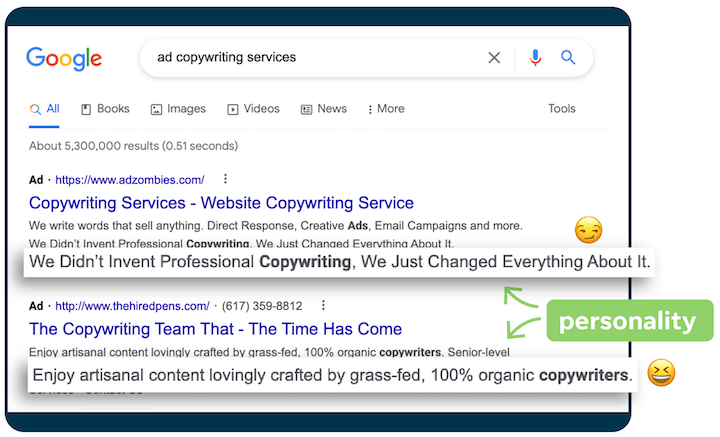
These ads stand out. Now I know that not every industry can be creative like this, but if it’s an option for you, I recommend taking a look at different Google Ads examples to get some inspiration.
(Side note: if you ever want ad copy ideas, just search “ad copywriting services” and you can rest assured that ad copy services will provide some inspiration.)
4. Get competitive
You know what they say…keep your friends close and your enemies closer. Keep an eye on what your competitors are using in their ad copy and use it for your own positioning. In the example below, you can see Got Print’s ad offering 500 business cards for $8.50. Right above that is Overnight Print’s ad for $8.49.
It’s a tiny detail—and I’ll admit borderline cheap trick—but does it catch your eye? Yes. And does this headline example also show that Overnight Prints is on the ball? Also yes.
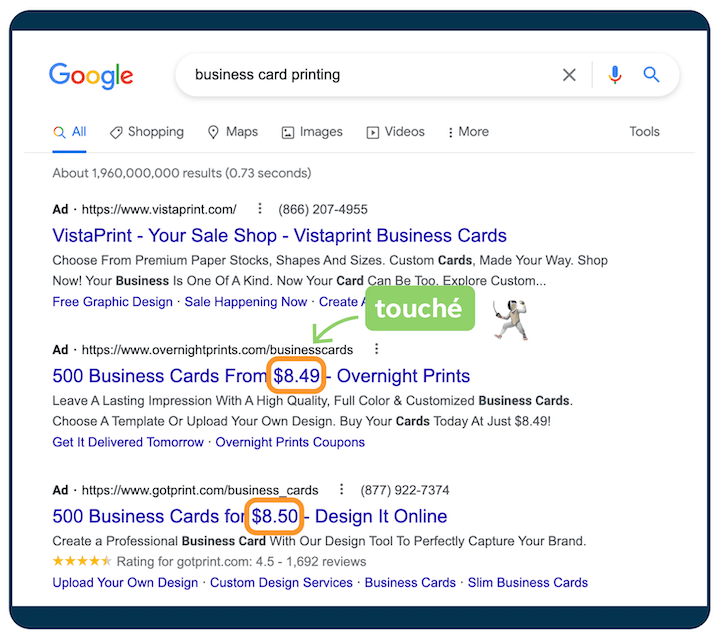
More competitive ad examples here.
Here’s another example. We have an ad for a family-owned-and-operated HVAC company at the top of the SERP (excellent differentiator, in addition to “serving since 1957”), and then right below it an ad that reads “Don’t hire those guys, really – we can beat their prices.”
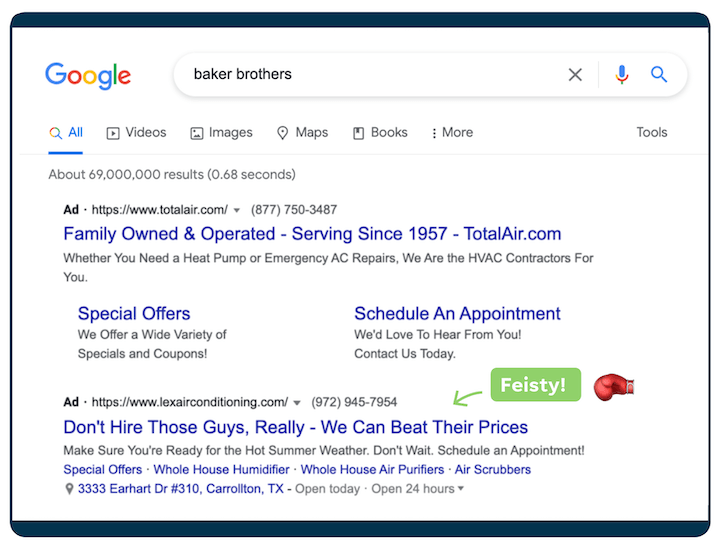
It’s a bold move, but being competitive reflects confidence in your business which imbues confidence in the audience. Plus, the conversational style of writing gives it personality.
5. Include a CTA in your headlines…
It would be naive to assume that every searcher reads every ad in its entirety, but headlines are difficult to skip over. So don’t hide your call to action in the description, put it out there for the world to see in your headline. This is likely to improve your CTR.
In the examples below, we have three ads. The first one doesn’t have a call to action phrase in the headline, but it does have a question. Questions do stand out and technically call forth some action in the form of thought. This one’s in the clear.
The second one has no CTA in the headline. Luckily there are CTAs in the description. The third one has a crisp and clean CTA to book a free 30-minute consult. Bingo.
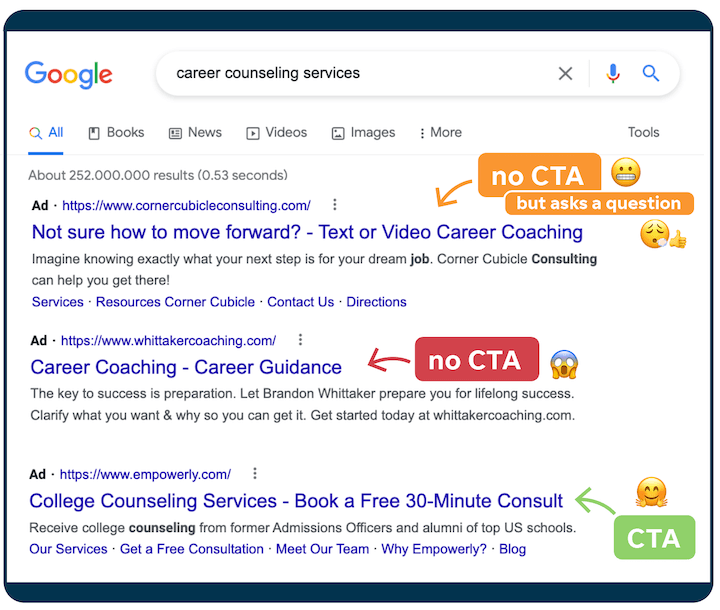
…highly specific CTAs
Notice how the CTA in the example above is super-clear? Avoid vague statements like “Buy Now” and “Learn More” and replace them with specific details. For example:
| Instead of this… | Try this |
|---|---|
| Buy Now and Save | Save $125 Off Your First Order. |
| Used Text Books for Sale | Buy Used Text Books for $30 |
| Sale Ends Soon | Claim Offer Before 9/25 |
| Learn More | Book a 30-Minute Call Today |
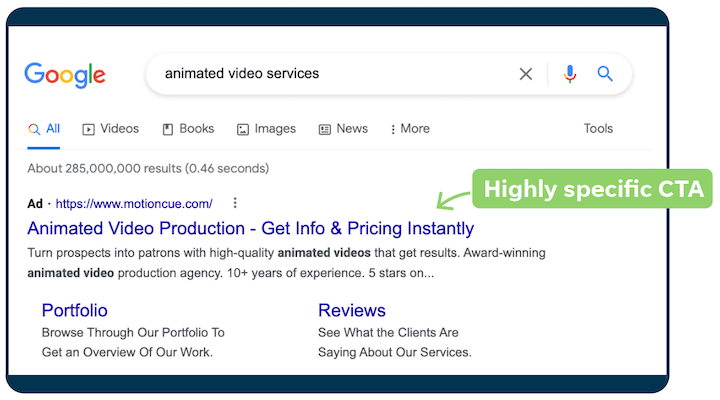
The better your prospects can see themselves performing the desired action, the more likely they are to take that action.
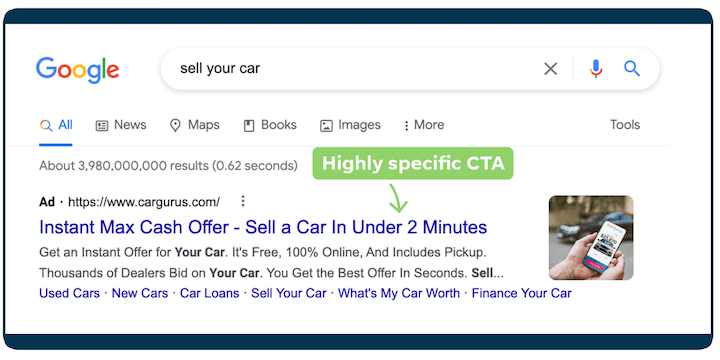
6. Use display paths
The display path is the text that appears after the URL associated with your ad. You’ve got two 15-character display paths to work with. These are optional, and they’re not guaranteed to show, but should you leave them blank? Nope.
Use display paths to show:
- Keywords
- Branded terms
- Call to action
- Your USP
In the example below, the ad uses /online-programs/get-info as the display paths to include the keyword and a call to action.
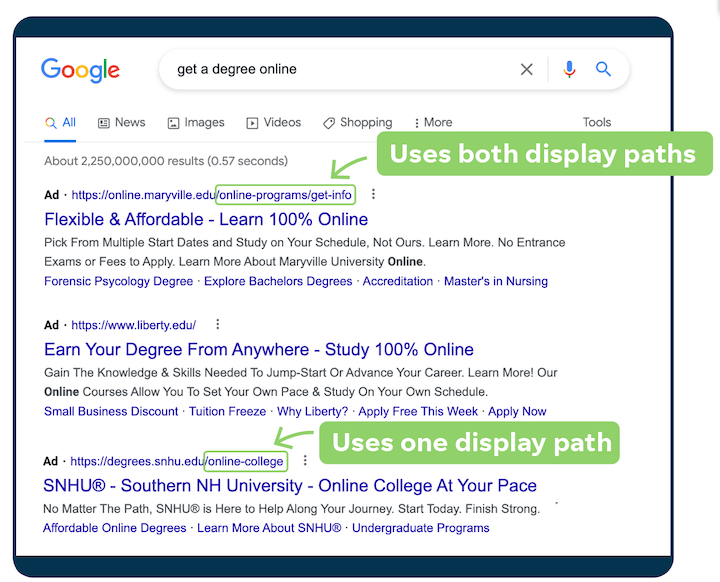
7. Reiterate and reinforce, but don’t be redundant
Yes, you want to make use of the space available to you in your ad, and yes, relevance to the keyword is important for Quality Score. But no, repeating the same keywords and phrases isn’t going to get you anywhere.
Including it once in your headline, display path, and/or description should be enough. Use the rest of the space for features, benefits, or related keywords. The idea is to reinforce or reiterate without being redundant.
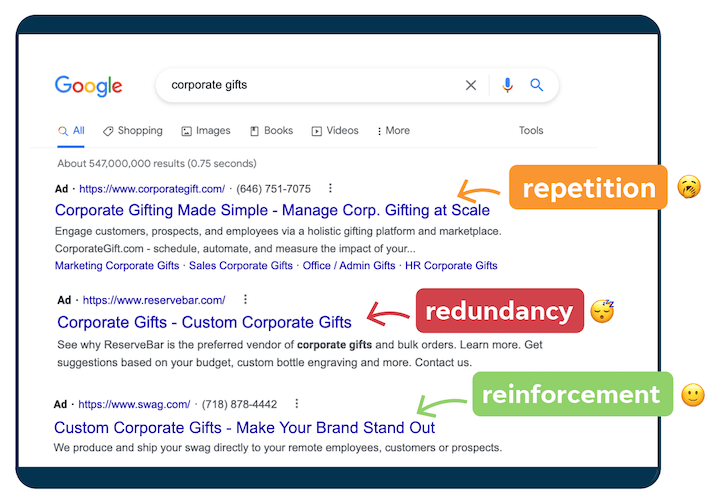
8. Try seasonal modifiers
Try using a seasonal headline in your ad, even if you offer your product or service year-round. This can encourage a sense of novelty and urgency and prompt clicks. In the example below, the headline reads “Fall Promo Ends 12/1.” Extra bonus points for the specificity of the date.
9. Address objections with the magic words
Even though intent to buy is pretty high on search, consumers are, by default, programmed with objections. These are specific to your product or service, but in general, they fall into one of three buckets:
- I can’t afford it
- It’s too much of a hassle
- I don’t need it
Fortunately, I’ve got a handful of magic words (and synonyms) that are excellent antidotes to these objections. They are as follows:
- Free: No cost, low cost, save, affordable, as low as, % off, only, cheap, bargain.
- Easy: Fast, instant, easy, simple, just, in minutes/days/hours, immediate, quick, jif
- Worth it: Return on investment, used by thousands, game-changing, you’ll never turn back.

10. Use relationships to evoke emotion
Coming full circle back to tip #1: Emotion is the most powerful ad copy tool at your disposal. Both positive and negative emotions influence behaviors. And what’s the best source for emotional ad copy? Relationships.
Way back when, Perry Marshall devised a structured approach to persuasive ad copy called the Swiss Army Knife. Blade #1 focuses on relationships, and in the model you have six key players:
- The customer
- Your business
- Something they love
- Something they hate
- Their best friend
- Their worst enemy
Among these six players there are 15 relationships you can play off of to create emotional hooks for your ads. For example:
- Don’t let [worst enemy] prevent you from [something they love].
- When [something they hate happens], [your business] [something they love].
- Free up time to [something they love] with [someone they love].
Just keep in mind that you don’t need to go over the top with your emotional words and phrases—especially with search ads. You want to evoke emotions so they inspire action, but not provoke them so they distract or come off as desperate or salesy. Oftentimes, a subtle approach works best.
In the example below, the headline reads “When Banks Say No, We Say Yes.” There aren’t even any emotional words in there, but you feel rejection and relief in a matter of seconds.
Part four: The free PPC ad copy template
Now it’s time to put these best practices and tips together. We covered a lot in this guide, and with the responsive component, it can be hard to make sure you cover it all. Which is why we’ve created this free PPC ad copy Google Sheet template.
It’s simple but sanity-saving. In it you’ll see eight different categories of headlines (or even phrases for your descriptions), which include:
- Keyword-focused: You need the keyword in your ad, of course, for relevance and Quality Score
- Benefits: What they stand to gain
- Features: How they gain the benefit
- Feelings/outcomes: Why they want the benefit (think emotions and relationships).
- Brand messaging: Taglines, brand names, value propositions
- Differentiators: Social proof, advantages over competitors, other specifics
- Pricing terms: Prices, discounts, promos, savings
- CTAs: Calls to action—remember, keep these super specific!
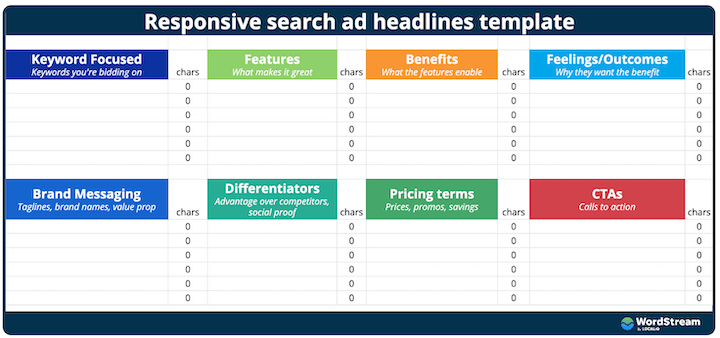
Click here to get the free template.
With a color-coded visual of these components, you can then make sure you’re mixing and matching accordingly.

Note that there’s a bucket for CTAs, but you could also just make sure you include headlines that have CTA language in each bucket.
The template has character counts so you can make sure you’re staying within your limits. And it’s fully customizable so you can create your own headline buckets.
Part five: Start writing irresistible PPC ad copy
You now are fully equipped to write compelling Google Ads that not only stand out and capture clicks, but that also maintain relevance. This is essential for maintaining your Quality Score, which impacts what you pay for each click. Here’s the quick recap:
- Think feature – benefit – feeling/outcome.
- Stand out from other ads with a differentiator.
- Include highly specific CTAs in your headlines.
- Don’t be afraid to get boldly competitive.
- Show personality with conversational tone and humor.
- Use display paths to include your keyword, CTA, and more.
- Reinforce and reiterate keywords, but don’t be redundant.
- Try seasonal modifiers to add novelty and urgency.
- Address objections with “free,” “easy,” and “worth it.”
- Use relationships to evoke emotion
The post 10 Tricks to Get the Click: How to Write Exceptional PPC Ads appeared first on WordStream.

